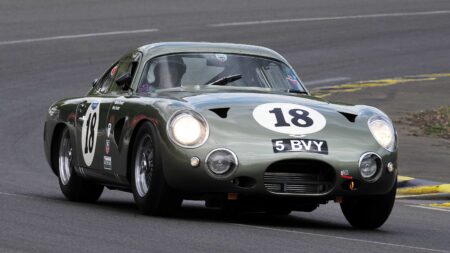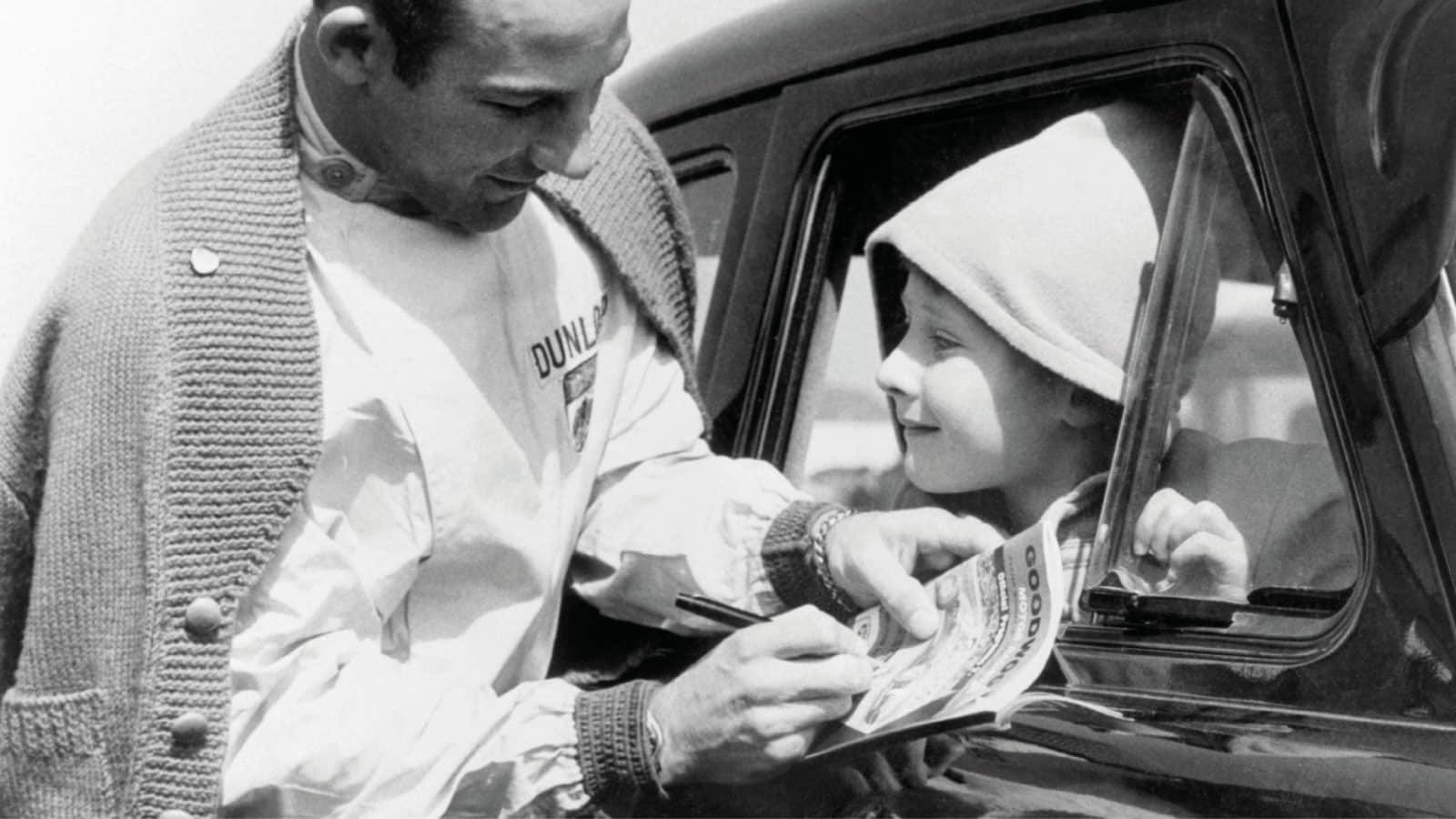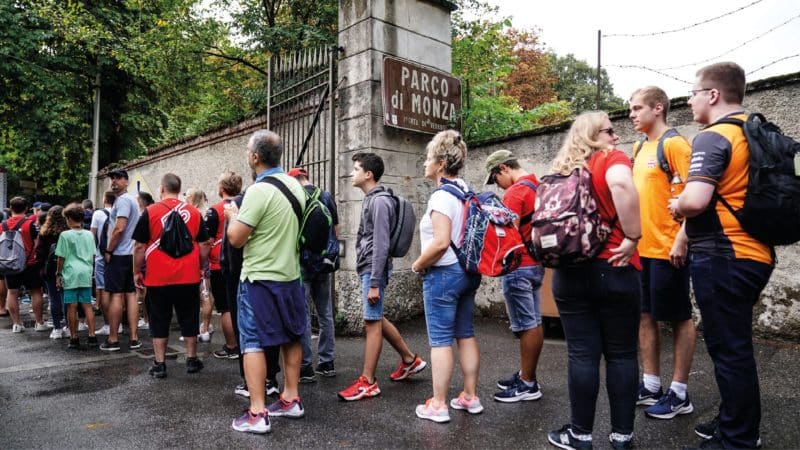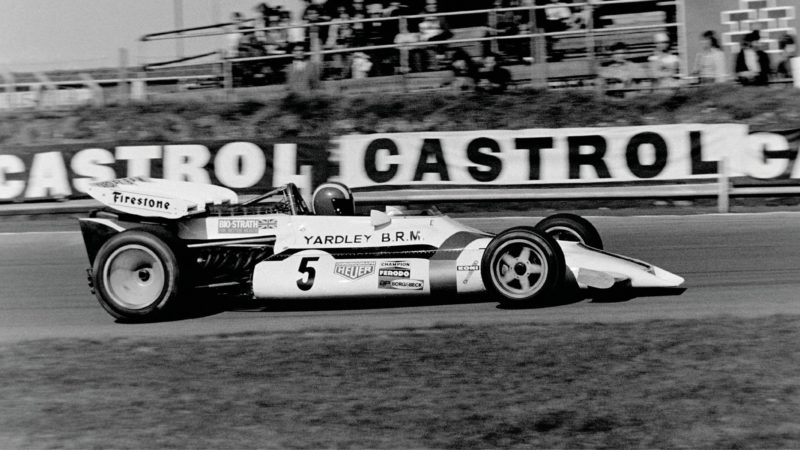
Aston Martin DP214 Recreation
There are no prizes in motor sport for resting on laurels which is why, three years after its celebrated 1-2 Le Mans performance with the 3-litre DBR1s in 1959, Aston…

Stirling Moss signs an autograph at Goodwood in 1960 for a boy called Christopher Carson. Wonder if the signature still exists...
Getty Images

Long queues, cramped conditions and full of Dutch drunks… welcome to Monza
Alamy
I have followed Ferrari through thick and thin since 1976. Each year since 1995 I have travelled to Monza to join the tifosi at the ‘Temple of Speed’. Sadly, this year was an organisational disaster. It took us two hours to walk in through the gate, following which our supplies of (sealed) water and soft drinks were taken from us by some very rude officials.
The crowds were excessive and pathways so narrow people could not pass. Many fell over and were simply walked on. The catering was dire and extortionate, purchased by a silly token system. The old days saw a myriad of private vendors selling good products at reasonable prices. Now one can only use the F1 official vending stands, which charge the earth. I would describe it all as ‘industrial scale greed’.
Crowd control was dangerous, thousands of people walking against each other through gates not wide enough to cope. It was a free-for-all. Several fights broke out and crushing was narrowly avoided.
The marshals were clueless and ill-informed. Once we had found our seats it became apparent that many unauthorised people were present, causing annoyance and confrontation. People were climbing through stands to take peoples’ paid seating.
Finally the partisan crowd: the Dutch fans were drunk and abusive and quite threatening to anyone who did not support Red Bull or Max Verstappen, chanting “You’re shit and you know you are” at the Ferrari supporters, causing real animosity and potential violence. This is why many booed Verstappen on the podium. At least Lewis called his supporters to order! Why not Verstappen, from whom we heard nothing?
I will return; however I hope things improve, for if they don’t I do not know how much longer I want to pay.
Richard Burgess, Doddinghurst, Essex
I would like to comment on Mike Doodson’s October Lotus story [Smoke and heat]. Mike and I were colleagues from late 1972, when I was hired to be his assistant by Noel Stanbury and Barry Foley. Our working environment at Stanbury Foley – the SFO, as it was known – was, as I describe in my book Black & Gold, a creative hothouse from which vivid new graphics and marketing concepts exploded on a daily basis onto the burgeoning motor sport scene of the early 1970s. Mike surfed the F1 grids and media centres on the back of that wave, and he understates the benefits accruing from having SFO as a base.
SFO’s admin offices and design studio occupied a former shop with warehouse at the rear, where JPS T-shirts were printed, while the clothing factory where the JPS Team Lotus apparel – including mechanics overalls and JPS rally jackets – were machined round the corner. All promotional material was carefully composed, designed and compiled, and in no sense “churned out”, but carefully distributed by mail and at trackside press centres.
We also produced a book following Emerson’s world title win in 1972, and, during 1973, we produced lavish black and gold press releases before and after every race, based on interviews with team manager Peter Warr and the F1 drivers. For the 1974 season – post Doodson – we also gave away a glossy black ring binder to the motor racing media that could be updated with post-race bulletins, and provided a photo library of race action shots. Wearing my JPS press officer’s hat I also attended every round of the Player’s Formula Atlantic Championship, as well as some grands prix and non-title F1 events.
As well as JPS black-and-gold and the Player’s No6 and No10 brands that bedecked the Norton motorcycle operation, SFO clients also included Texaco, Team Surtees, Rondel Racing and Motor Circuit Developments who owned Brands, Mallory, Oulton and Snetterton, for whom SFO produced similar promo items to the Player’s inventory. It was all go, and we virtually lived at circuits at weekends. There was more to it than Mike reveals.
Johhny Tipler, Cromer, Norfolk
I have just read the editorial in your October issue and the reference to the memorial to Jo Siffert at Bourne [The Editor]. I was at Brands Hatch that dreadful day, standing at the top of Druids, when a pall of smoke rose from Hawthorn Bend. From the bridge I saw what had happened. On several previous laps I had noticed the BRM in particular grounding quite heavily going up Hawthorn Hill. I have always suspected this may have destabilised Siffert’s car as he started to brake into the right-hander at speed and worsened the suspension damage suffered at the beginning of the race. Perhaps suspension damage caused the grounding?
I had been a keen follower of his career, together with that of Pedro Rodriguez, in the Porsche 917 campaign and had seen him drive at Brands previously that year in the BOAC 1000Kms. His death was one of the many tragic losses during that period. What marvellous and brave characters those drivers were – and what wonderful but lethal machines they raced.
Philip Prettejohn, via email

Jo Siffert at the 1971 World Championship Victory Race at Brands Hatch – his final race
Getty Images
I have one particularly vivid memory of the Mallory Park circuit (November issue) [Star turn] going back to 1989. My Leicestershire-based firm had the exclusive distributorship for Slick 50, the best-selling oil additive of the day, and Roger Clark of rally fame was the product ambassador. Deciding that we needed a PR stunt to prove the protective abilities of Slick 50 in a rally car when typically the sump might have been cracked open on a rock, our PR company decided that an oil-free demonstration at Mallory Park would get plenty of press interest.
Roger was on the Mallory start line in a Fiat Strada with no engine oil in it (with the sump plug in the RAC observers pocket) and the control experiment alongside was my secretary’s Renault also with no oil in the sump driven by one of the journalists present. Both cars set off at the same time, but strictly limited to 50mph, and after one lap the Renault expired in a cloud of black smoke.
After 10 laps Roger was getting visibly bored, tied down to a maximum speed of 50mph, and after 40 laps he shouted out of the window, “Can I come in?” I should add that this was in the afternoon and it was Roger’s habit to spend lunchtime in the Black Bull in Peckleton, and as this had been no different to any other day his needs were pressing.
After 49 laps we decided that the point had been made and at 50 laps we pulled him in to his great relief and left the car sitting on the start line with a red-hot engine and Roger rushing for the gents. But the point had been made and we derived much publicity from it.
Chris Mitchell, Houghton on the Hill, Leics
Echoing Rob Gent’s letter from November’s issue about the Silverstone Maggots/Becketts development, we too approached Maggots during the Classic with a sinking feeling on seeing the steel and concrete looming up ahead. On arrival we had a great view of the marshal’s feet but not much else. Fortunately there were only a few spectators and we could stand atop the concrete barrier for a good view of the wonderful Historic F1.
How many of the current ‘money’ men ever watched from the now gone raised viewing at Maggots? Few, I suspect. Fond memories indeed are held of V10/V12, and, OK, V8 era F1 at Maggots. An astonishing assault on the senses. The place to watch for anyone, especially those who didn’t ‘get’ F1. Surely one of the best viewing spots at any circuit in the world now wiped away as if it never mattered. Move along motor racing enthusiast, nothing to see here…
Peter Rosier, Walton-on-Thames, Surrey
I was interested to read Mike Doodson’s retrospective piece [The real Drive to Survive, November], particularly the reference to the short-lived Amon Engines operation.
Tetsu Izukawa was not the only F2 driver to fit an Amon unit; at the 1972 Jochen Rindt Trophy in Austria, the works March squad briefly used one in Niki Lauda’s No3 car. In the first season of the new formula the stretched 1600 units were notoriously unreliable, and by this point in the season Lauda had already consumed 10 engines in seven F2 races.
The event was hard on motors and Niki went through five in practice, the final blow-up being one that had been stripped down and rebuilt from the remains of others. With no other engines, a replacement unit from Amon’s engine-preparation business was flown out, but this too failed to run well, so an old Race Engine Services-prepared mill was reinstalled. The Amon unit was never raced by the works.
Lauda was lucky that the event was taking place in Austria; the organisers validated Friday’s practice times for qualifying so his best lap from that day got him into the race. However, his bad luck continued and he retired with loss of oil pressure after only seven laps.
Jon Saltinstall, Market Harborough
I note the observations of Doug Nye with respect to autograph hunters in the November 2022 edition [The Archives]. While my own autograph collection mainly comprised footballers and cricketers from the 1960s, my eldest son spent many happy hours at Silverstone and Goodwood chasing signatures for his own album. The advent of the ‘professional’ has been clearly evident for many years now but particularly since the arrival of internet sales platforms. The sight of people with piles of photographs, books and posters at Goodwood is a common one. Younger spectators looking for a driver or rider to sign their book or programme are often pushed to the side by dealers to the extent that the celebrity eventually gets fed up and strides off.
I have witnessed astonishing patience shown by the likes of Sir Stirling Moss, JYS, Jenson Button, Alan Jones and the ever-cheerful Brian Redman. Of course there is always a time and a place for autographs but I well recall my son being refused a signature by Messrs Montoya, Boutsen, R Schumacher, Damon Hill and even the sainted Murray Walker, all of whom fell off my lad’s Christmas card list!
Tony Boullemier, Hanging Houghton, Northants
I feel the whole concept of a ‘Triple Crown’ has been distorted. The original quest was an equine competition and requires the winner to have had all three wins consecutively in the same season. This is the reason why the original motor sport Triple Crown was considered to be winning all three of the American 500-mile races in a season. Only one person did that – Al Unser Sr, in 1978. No driver did that after him, and one of the tracks at which he won no longer exists, so no one will.
Norman E Gaines Jr, Hartsdale, NY, USA
What fabulous news that Ralph Firmin Jr is returning the Van Diemen name to once again grace the race tracks [Matters of Moment, November]. Along with Lola’s recent announcement, it will bring two prominent British customer car manufacturers back to motor sport. Both these hugely experienced constructors know how to produce top-quality products, so I hope it will be simple for them to compete with the likes of Dallara, Tatuus, etc.
Maybe they could both go back to their roots and build some new FF1600 chassis, as this is still one of the few classes that is still open to anyone who wants to enter. Whatever happens, it is terrific news for the British motor sport industry to have these historic names competing again.
Michael Skeet, Southampton
Write to Motor Sport, 18-20 Rosemont Road, London, NW3 6NE
e-mail, [email protected]